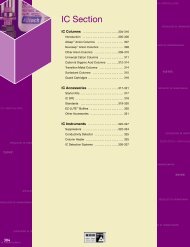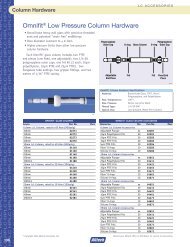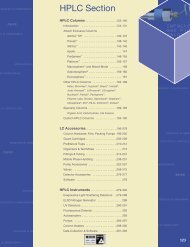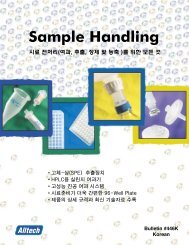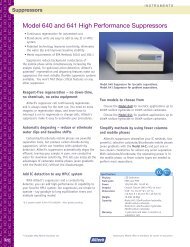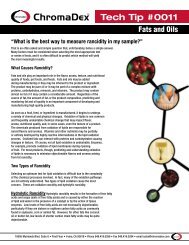GC Accessories
GC Accessories
GC Accessories
Create successful ePaper yourself
Turn your PDF publications into a flip-book with our unique Google optimized e-Paper software.
A C C E S S O R I E S<br />
Purifiers<br />
Physical Characteristics<br />
You will also need to consider what physical<br />
characteristics your purifier should possess to meet your<br />
application requirements. Do you require 1/8" or 1/4"<br />
fittings, or are you performing bulk gas purification<br />
that requires 1/2" fittings? What are the pressure<br />
requirements of your application? This will determine if<br />
you need a purifier with a polycarbonate, glass, or metal<br />
body. Where will you be installing the purifier and is<br />
your installation space limited? This will determine the<br />
dimension and style of purifier you should choose.<br />
Purifier Styles<br />
Alltech offers three purifier styles – in-line, baseplate,<br />
and cartridge. The in-line style is the traditional style<br />
that is most commonly used. It can be directly installed<br />
into your gas lines with no support depending on its<br />
dimension or can be easily mounted on the wall with<br />
mounting clips. In-line purifiers must be removed from<br />
the gas line to be refilled or regenerated. We recommend<br />
installing them with quick-connect connectors and<br />
keeping an extra purifier on hand.<br />
The baseplate and cartridge purifiers sit on the<br />
countertop making them easy to access when it is time<br />
to replace spent traps. Both styles can be installed in<br />
series with shut off valves allowing you to easily isolate<br />
them from your gas lines when it is time to replace<br />
them. Baseplate units allow you to easily refill the<br />
purifier with new adsorbent material. Cartridge purifiers<br />
allow you to quickly remove the spent purifier from your<br />
gas line and replace it with a new one.<br />
Purifier Capacity<br />
Purifier capacity indicates the amount of contaminant<br />
a trap is capable of removing before it reaches its point<br />
of saturation. It is dependent on both the adsorbent’s<br />
capabilities and purifier’s volume. You need to consider<br />
the amount of impurities in your gas stream and the<br />
volume of gas you need to purify. If you are purifying a<br />
large volume of gas or a less pure gas, you should select<br />
a high capacity trap with a large volume adsorbent bed<br />
that will trap and retain more contaminants.<br />
Purifier Efficiency<br />
Purifier efficiency is the most important purifier<br />
characteristic. It indicates how effective the adsorbent<br />
is at removing the desired contaminant from your gas<br />
stream. If your application requires high purity levels<br />
or the lowest detection limits, select a purifier that is<br />
packed with a highly efficient adsorbent material that<br />
removes contaminants to ppb levels.<br />
<br />
<br />
Figure 1 — How to Set Up Carrier Gas Purifiers<br />
1. High Capacity or Indicating Moisture Trap<br />
2. High Capacity or Indicating Hydrocarbon Trap<br />
<br />
<br />
<br />
<br />
<br />
<br />
Gas Purifier Installation Order<br />
The order in which you install purifiers into your gas<br />
lines is very important. Figure 1 demonstrates the<br />
correct order for installing purifiers into your carrier<br />
gas line. The moisture trap should be placed first in<br />
line. Both hydrocarbon and oxygen traps will adsorb<br />
water. Installing a moisture trap before these traps<br />
prevents them from becoming prematurely saturated with<br />
moisture. It also allows them to more effectively remove<br />
their specified contaminants from the gas stream. The<br />
hydrocarbon trap should be placed after the moisture<br />
trap. A high capacity oxygen trap and an indicating<br />
oxygen trap should be placed closest to the <strong>GC</strong>. We<br />
recommend installing the series of purifiers as close to<br />
the <strong>GC</strong> as possible.<br />
Gas purifiers should be installed in a vertical position<br />
to prevent channeling. Channeling is a phenomenon<br />
that occurs when a purifier is installed in a horizontal<br />
position. The adsorbent bed settles and the gas stream<br />
passes over the top of the bed rather than through the<br />
bed. The gas stream does not sufficiently interact with<br />
the adsorbent bed to effectively remove impurities.<br />
Gas purification systems simplify purifier installation<br />
in to your gas lines. Systems are available as multiadsorbent<br />
single purifiers or compact panels that contain<br />
multiple purifiers.<br />
Purifier Replacement/Regeneration<br />
3. Oxygen Trap (high<br />
capacity)<br />
4. Indicating Oxygen<br />
Trap<br />
You need to replace your gas purifiers before they<br />
are fully saturated. You can either change them at a<br />
predetermined time interval or use an indicating trap<br />
that changes color as it becomes saturated. There<br />
are potential problems with scheduled replacements.<br />
Undetected leaks or accidental exposure to air during<br />
cylinder changes can prematurely saturate gas purifiers.<br />
Early breakthrough means your column and detectors are<br />
exposed to a constant stream of damaging contaminants.<br />
An indicating trap located downstream from a high<br />
capacity trap is the best way to determine when it’s<br />
time to replace a spent trap. Some purifiers contain<br />
both the high capacity and indicating adsorbent in the<br />
same purifier body while others rely on a separate trap<br />
that serves solely as an indicator. Either way, purifier<br />
replacement should coincide with the first signs of color<br />
change in the indicating adsorbent.<br />
© Copyright 2004 Alltech Associates, Inc.<br />
Contact your Alltech office or distributor for current or local prices.<br />
4138<br />
399





